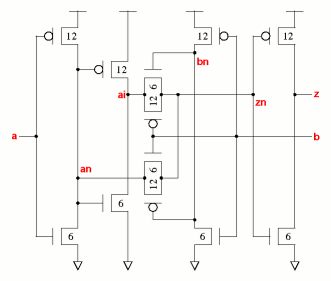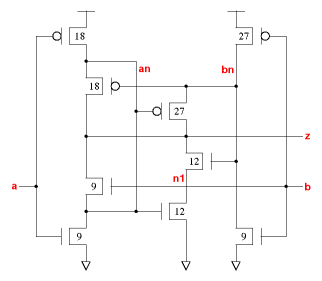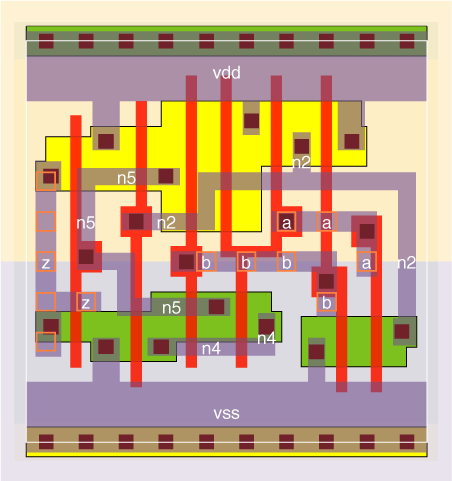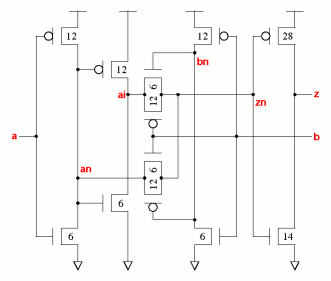xor2 standard cell family

| pin a | pin b | pin a | pin b | ||
| inverting | non-inverting | ||||
| xor2v0x1 | 84 | 78 | 97 | 102 | |
| xor2v1x1 | 88 | 71 | 106 | 87 | |
| xor2v2x1 | 78 | 70 | 107 | 100 | |
| xor2v3x1 | 86 | 84 | 126 | 122 | |
| xor2v4x1 | 79 | 71 | 152 | 121 | |
| xor2v5x1 | 81 | 78 | 126 | 123 | |
| xor2v6x1 | 92 | 81 | 120 | 126 | |
| xor2v7x1 | 166 | 171 | 124 | 111 | |
| xor2v8x1 | 155 | 122 | 127 | 102 | |
There are a number of ways to implement an XOR gate,
and 9 of them are shown here.
- xor2v0 has the smallest number of transistors.
- xor2v1 is the classic two inverters with transfer gate onto the
output node.
- xor2v2 is an alternative inverter plus transfer gate configuration.
- xor2v3 is an aoi22 with input inverters.
- xor2v4 is an oai22 with input inverters.
- xor2v5 is the aoi22 or oai22 with the connexion
for the parallel P or N transistors removed.
- xor2v6 is like the xor2v5 but with a connexion
for both the parallel P or N transistors.
- xor2v7 is a 2-NAND and OR-NAND combination with output buffering
inverter. The schematic came from a public web site; the layout uses
wsclib rules.
- xor2v8 is a xnr2v1 with an inverter output.
This is a common style in commercial standard cell libraries.
XOR2 gates are one of the most common gate types: in most designs they
are amongst the top-10 used cells. Their speed has a direct impact on
overall circuit performance, as they are widely used in arithmetic
functions. The 9 variants here have been characterised in the generic
0.13um technology, and a summary of their performance is shown in
the table below.
The fastest inverting gate is the xor2v2 on pin b.
The fastest non-inverting gate is the xor2v1 on pin b,
but this is slow for pin a.
The xor2v0 is slower but smaller.
The xor2v3/v4/v5/v6 gates have very similar
performances. The ones with larger diffusion parasitic capacitances
have simpler layouts and lower metal parasitics. All these gates aren't
really needed but are included to show their performance.
The xor2v3x1 is similar to the sxlib xr2_x1.
The xor2v7 is fairly nasty. It's big and slow, and the transistors
are wrongly sized. The non-inverting path is quicker because the
inverting path uses 3 stage delays, rather than the single stage delay
of the other gates.
The xor2v8 is also a 2/3 stage delay gate which is slower than the others.
The average delay of each x1 gate and pin when driving just itself in
a ring oscillator, inverting and non-inverting modes,
is shown on the right.





































